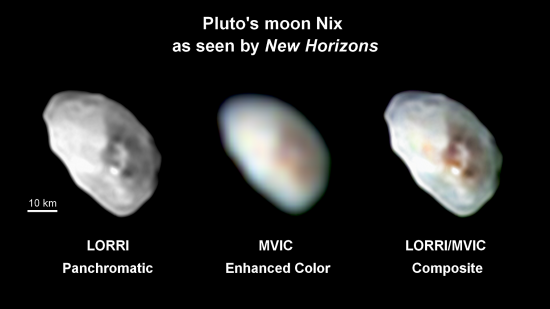May 24, 2016
Pluto’s potato-shaped moon.
The New Horizons space probe flew by the dwarf planet Pluto on July 14, 2015. Its images of Pluto and Charon, along with infrared and spectral analyses, will provide planetary scientists with enough data to keep them occupied for years to come. More images are being sent from the craft’s memory over time, with an estimated full download sometime in the middle of 2016.
Pluto’s moon Charon is almost as large as the dwarf planet, itself. It has been suggested by several astronomers that Pluto and Charon are a binary system. Along with Charon are many smaller moons, some equivalent in size to asteroids; exhibiting asymmetrical structure and anomalous formations. Nix, in particular, is an unusual moon with a potato-shape and a crater that should have blown it to pieces if it were caused by an impact event. At 54 kilometers by 41 kilometers by 36 kilometers, Nix is about the same size as Saturn’s moon, Epimetheus.
In previous Picture of the Day articles about small moons, it was suggested that they do not shatter upon impact with other objects because it was not impacts that created the craters in question. Saturn’s moons, Tethys and Mimas are good examples of the problem. The supposed explosions that formed each of the large craters on their hemispheres should have been powerful enough to crack them apart.
Instead of exerting a shattering force, as an impact would do, an electric arc would dissociate surface material and lift the debris into space along field-aligned current channels. The electric force would fall off rapidly on the edges of the arc, forming craters with steep or vertical sidewalls and “pinched up” rims, contrary to the “blown out” rims from an impact.
A plasma discharge, such as a lightning bolt, consists of two or more filaments rotating around a central axis. Such a discharge would cut to uniform depth, producing a flat floor. An impact, on the other hand, would excavate a hole of varying depth because impact forces decrease radially instead of being constant over the entire surface. Finally, the moon’s distinctive shape might be due to other manifestations of electricity in space.
The z-pinch (or Bennett pinch) phenomenon can force matter into smaller and smaller volumes, squeezing it into a characteristic distortion at right angles to the energy flow. The structure of Atlas, one of Saturn’s smallest moons, exhibits a dramatic example of that potential power. Atlas is 40 kilometers long by 20 kilometers wide and rotates around its flattened plane.
The Solar System is not a neutral environment, is highly charged and electrically active. At some time in the past, according to Electric Universe theory, it experienced a violent upheaval that saw plasma discharges and incredibly intense auroral curtains sweep through the solar system. Any celestial bodies within the range of the outburst would have been hammered by electricity, bombarded with intense radiation, heated and half-melted and then blasted with lightning bolts. All of that energy could have created the distinctive shape of Nix, as well as etching its over-sized crater.
Stephen Smith
Hat tip to Larry White













